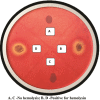Candiduria-Study of Virulence Factors and Its Antifungal Susceptibility Pattern in Tertiary Care Hospital
- PMID: 34602787
- PMCID: PMC8478503
- DOI: 10.1055/s-0041-1730880
Candiduria-Study of Virulence Factors and Its Antifungal Susceptibility Pattern in Tertiary Care Hospital
Abstract
Background The increased incidence of candiduria in hospitalized patients is due to the use of indwelling devices, long-term antibiotics, parenteral nutrition, and immunocompromised status of the patient. In this study, an attempt was made to speciate, characterize, and determine the antifungal susceptibility pattern of Candida isolated from urinary tract infections (UTIs). Materials and Methods A total of 70 Candida isolates were obtained from urine samples. The isolated Candida species were studied for the production of virulence factors like phospholipase, protease activities, hemolysin, and biofilm production. Antifungal susceptibility testing of the isolated yeasts was done using Mueller-Hinton agar supplemented with 0.5 mg/mL methylene blue by E-test method for amphotericin B, fluconazole, caspofungin, and voriconazole. Results Out of 70 isolates, Candida tropicalis was the most frequently isolated species (65.7%), followed by Candida albicans (14.3%), Candida glabrata (7.1%), Candida krusei (5.7%), Candida parapsilosis (4.3%), and Candida dubliniensis (2.9%). A total of 37.1% were biofilm producers, 62.9% showed proteinase activity, 38.6% were phospholipase positive, and 58.6% isolates showed hemolytic activity. Antifungal susceptibility profile of Candida species showed 38.6, 25.7, 15.7, and 12.9% resistance to amphotericin B, fluconazole, caspofungin, and voriconazole, respectively. Conclusion A rising trend in isolation of non-albicans Candida from urinary isolates was noticed, which was statistically significant when comparing catheterized and noncatheterized urinary isolates from our study. However, there was no statistically significant difference when different virulence factor expressions were compared among Candida spp. isolated from catheterized and noncatheterized urinary samples. Due to this rise in non-albicans Candida species causing UTI that are intrinsically resistant to certain antifungal agents like azoles and increasing incidence of antifungal resistance, it is essential to monitor the antifungal susceptibility profile of Candida species causing candiduria.
Keywords: biofilm; hemolysin; phospholipase; proteinase; virulence.
The Indian Association of Laboratory Physicians. This is an open access article published by Thieme under the terms of the Creative Commons Attribution-NonDerivative-NonCommercial-License, permitting copying and reproduction so long as the original work is given appropriate credit. Contents may not be used for commercial purposes, or adapted, remixed, transformed or built upon. (https://creativecommons.org/licenses/by-nc-nd/4.0/).
Conflict of interest statement
Conflict of Interest None declared Approval This study was done after approval by Institutional Human Ethical Committee.
Figures
Similar articles
-
Candida and candidaemia. Susceptibility and epidemiology.Dan Med J. 2013 Nov;60(11):B4698. Dan Med J. 2013. PMID: 24192246 Review.
-
High prevalence of asymptomatic nosocomial candiduria due to Candida glabrata among hospitalized patients with heart failure: a matter of some concern?Curr Med Mycol. 2020 Dec;6(4):1-8. doi: 10.18502/cmm.6.4.5327. Curr Med Mycol. 2020. PMID: 34195453 Free PMC article.
-
[Investigation of antifungal susceptibilities and some virulence factors of Candida strains isolated from blood cultures and genotyping by RAPD-PCR].Mikrobiyol Bul. 2011 Apr;45(2):306-17. Mikrobiyol Bul. 2011. PMID: 21644074 Turkish.
-
Profile of yeasts isolated from urinary tracts of catheterized patients.J Clin Diagn Res. 2014 Feb;8(2):44-6. doi: 10.7860/JCDR/2014/6614.4003. Epub 2014 Feb 3. J Clin Diagn Res. 2014. PMID: 24701478 Free PMC article.
-
Non-albicans Candida spp. causing fungaemia: pathogenicity and antifungal resistance.J Hosp Infect. 2002 Apr;50(4):243-60. doi: 10.1053/jhin.2001.1151. J Hosp Infect. 2002. PMID: 12014897 Review.
Cited by
-
Candidemia Among ICU Patients: Species Characterisation, Resistance Pattern and Association With Candida Score: A Prospective Study.Cureus. 2022 Apr 29;14(4):e24612. doi: 10.7759/cureus.24612. eCollection 2022 Apr. Cureus. 2022. PMID: 35651467 Free PMC article.
-
Acute obstructive fungus ball pyelonephritis with Candida parapsilosis: A case report.Clin Case Rep. 2023 Jun 9;11(6):e7484. doi: 10.1002/ccr3.7484. eCollection 2023 Jun. Clin Case Rep. 2023. PMID: 37305879 Free PMC article.
-
Distribution and antifungal susceptibility of Candida species causing vulvovaginal candidiasis and urinary tract infection in Medlatec healthcare system, Ha Noi city, Vietnam in 2023.Ther Adv Infect Dis. 2025 Jan 6;12:20499361241311465. doi: 10.1177/20499361241311465. eCollection 2025 Jan-Dec. Ther Adv Infect Dis. 2025. PMID: 39781278 Free PMC article.
-
Characterization of Candida species isolated from clinical specimens: insights into virulence traits, antifungal resistance and molecular profiles.BMC Microbiol. 2024 Oct 5;24(1):388. doi: 10.1186/s12866-024-03515-x. BMC Microbiol. 2024. PMID: 39367309 Free PMC article.
-
Mixed Fungal Biofilms: From Mycobiota to Devices, a New Challenge on Clinical Practice.Microorganisms. 2022 Aug 26;10(9):1721. doi: 10.3390/microorganisms10091721. Microorganisms. 2022. PMID: 36144323 Free PMC article. Review.
References
-
- Kauffman C A, Fisher J F, Sobel J D, Newman C A. Candida urinary tract infections—diagnosis. Clin Infect Dis. 2011;52 06:S452–S456. - PubMed
-
- Agarwal S, Manchanda V, Verma N, Bhalla P. Yeast identification in routine clinical microbiology laboratory and its clinical relevance. Indian J Med Microbiol. 2011;29(02):172–177. - PubMed
-
- Larone D H.Medically Important Fungi: A Guide to Identification. 5th ed. Washington DC: ASM press2011
-
- Tsang C SP, Chu F CS, Leung W K, Jin L J, Samaranayake L P, Siu S C.Phospholipase, proteinase and haemolytic activities of Candida albicans isolated from oral cavities of patients with type 2 diabetes mellitus J Med Microbiol 200756(Pt 10)1393–1398. - PubMed
-
- Samaranayake L P, Raeside J M, MacFarlane T W. Factors affecting the phospholipase activity of Candida species in vitro. Sabouraudia. 1984;22(03):201–207. - PubMed
LinkOut - more resources
Full Text Sources
Miscellaneous






